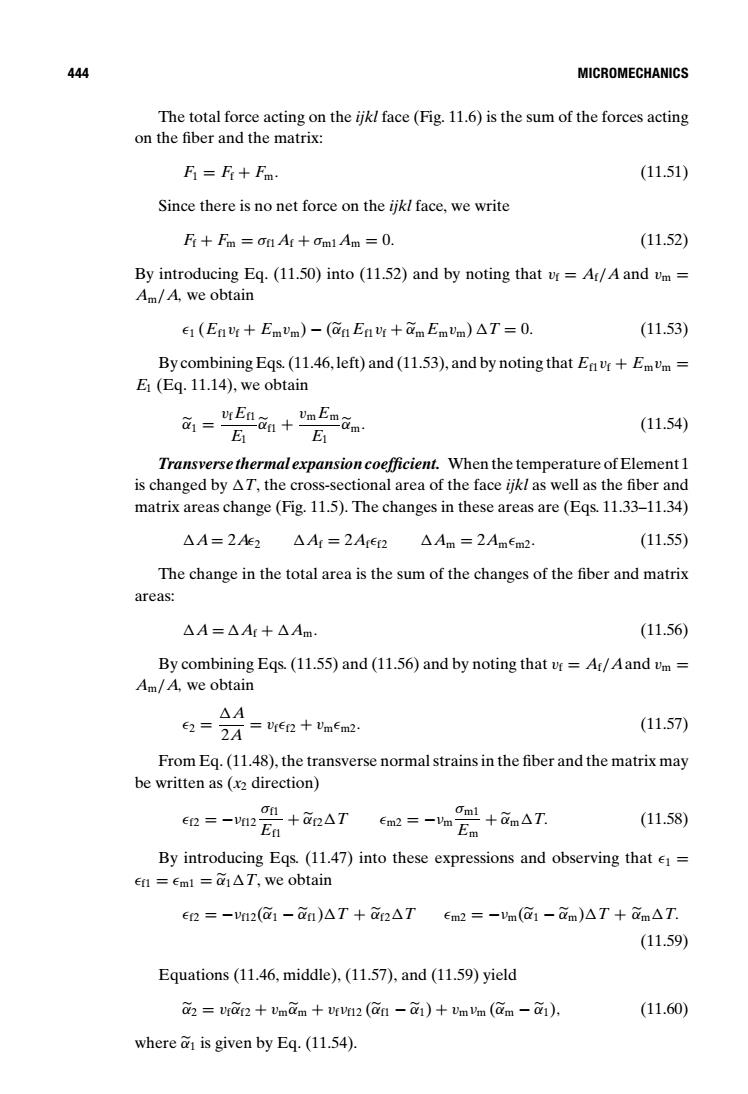正在加载图片...

444 MICROMECHANICS The total force acting on the ijkl face(Fig.11.6)is the sum of the forces acting on the fiber and the matrix: F=F+Fm. (11.51) Since there is no net force on the ijkl face,we write F+Fm of At om1 Am =0. (11.52) By introducing Eq.(11.50)into (11.52)and by noting that vr=Ar/A and vm Am/A,we obtain E1(Ervr+Emvm)-(an Envr+am Emvm)AT=0. (11.53) By combining Eqs.(11.46,left)and (11.53),and by noting that Envr EmUm E1(Eq.11.14),we obtain d1=En an VmEm dm (11.54) E E Transverse thermal expansion coefficient.When the temperature of Element 1 is changed by AT,the cross-sectional area of the face ijkl as well as the fiber and matrix areas change (Fig.11.5).The changes in these areas are(Eqs.11.33-11.34) △A=2Ae2△A=2Are2 △Am=2Amem2. (11.55) The change in the total area is the sum of the changes of the fiber and matrix areas: △A=△Ar+△Am (11.56) By combining Eqs.(11.55)and (11.56)and by noting that vr=Ar/Aand vm Am/A,we obtain △A E2-=Urep+Umem2. (11.57) From Eq.(11.48),the transverse normal strains in the fiber and the matrix may be written as (x2 direction) +a△T =-12E oml+am△T. ∈m2=-mEm (11.58) By introducing Egs.(11.47)into these expressions and observing that e1= en =Emi =AT,we obtain e2=-12(a1-an)△T+af2△Tem2=-m(a1-am)△T+am△T. (11.59) Equations (11.46,middle),(11.57),and (11.59)yield a2 vrar2 Umam vrvr2 (an-a1)+vmVm (am-a1), (11.60) where @i is given by Eq.(11.54).444 MICROMECHANICS The total force acting on the ijkl face (Fig. 11.6) is the sum of the forces acting on the fiber and the matrix: F1 = Ff + Fm. (11.51) Since there is no net force on the ijkl face, we write Ff + Fm = σf1Af + σm1Am = 0. (11.52) By introducing Eq. (11.50) into (11.52) and by noting that vf = Af/A and vm = Am/A, we obtain 1 (Ef1vf + Emvm) − (αf1Ef1vf + αm Emvm)
T = 0. (11.53) By combining Eqs. (11.46, left) and (11.53), and by noting that Ef1vf + Emvm = E1 (Eq. 11.14), we obtain α1 = vfEf1 E1 αf1 + vm Em E1 αm. (11.54) Transverse thermal expansion coefficient. When the temperature of Element 1 is changed by
T, the cross-sectional area of the face ijkl as well as the fiber and matrix areas change (Fig. 11.5). The changes in these areas are (Eqs. 11.33–11.34)
A= 2A2
Af = 2Aff2
Am = 2Amm2. (11.55) The change in the total area is the sum of the changes of the fiber and matrix areas:
A =
Af +
Am. (11.56) By combining Eqs. (11.55) and (11.56) and by noting that vf = Af/Aand vm = Am/A, we obtain 2 =
A 2A = vff2 + vmm2. (11.57) From Eq. (11.48), the transverse normal strains in the fiber and the matrix may be written as (x2 direction) f2 = −νf12 σf1 Ef1 + αf2
T m2 = −νm σm1 Em + αm
T. (11.58) By introducing Eqs. (11.47) into these expressions and observing that 1 = f1 = m1 = α1
T, we obtain f2 = −νf12(α1 − αf1)
T + αf2
T m2 = −νm(α1 − αm)
T + αm
T. (11.59) Equations (11.46, middle), (11.57), and (11.59) yield α2 = vfαf2 + vmαm + vfνf12 (αf1 − α1) + vmνm (αm − α1), (11.60) where α1 is given by Eq. (11.54).����������������������